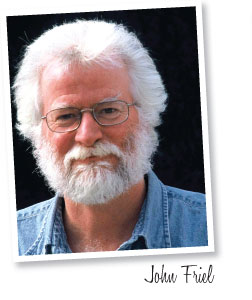6/1/2018
Dancin’ With Darwin
John Friel

I’ve learned many things while boating, but I’ve been pretty oblivious to many more. Take the Osage orange: It never occurred to me to ponder its big knobby green fruits other than as potential Christmas ornaments. I’ve filled buckets with them from my kayak. Painted silver and red, they’re quite festive.
Is that why the tree scattered them along the bank? Not likely.
A more probable scenario is painted by Professor Joe Boggs’ excellent article, “Honeylocusts and Mastodons.” Those big, tough, fibrous seed packages and the tough, thorny trees that drop them evolved alongside big, tough animals—megafauna that are now extinct.
It’s undeniable to anyone but evolution-deniers that plants and animals are locked in a lifelong symbiotic embrace. Think foxgloves and bumblebees, deep-throated cactus flowers and long-tongued moths, kale and hipsters.
Boggs cites the honeylocust’s large, lethal spines, bristling in puzzling places. But in 1982, two scientists—one in Pennsylvania, one in Arizona—pointed out that they’re perfectly positioned to thwart a mastodon’s groping trunk, keeping seed pods safe until they were ready to germinate.
Boggs also cites the Osage, whose oversize fruits now mostly rot on the ground because there are no longer mastodons—huge elephant-like beasts—to eat them and poop out their seeds elsewhere, expanding the tree’s range. Where I live only deer and squirrels eat them, and not as Choice A. Ergo, the tree’s range spreads slowly if at all.
Boggs’ otherwise wonderful piece left me just slightly dissatisfied: I sensed a tacit assumption that this mutually-beneficial dance occurred way back when and that the music has since stopped playing. It hasn’t.
He does note, “Natural selection has not had time to reduce, modify or erase characteristics that once bestowed great rewards.” To my ear—perhaps I’m being oblivious again—that stops short of saying plants and beasts, Homo sapiens included, are still in flux. Evolution, via mutations and selections, is a beat that goes on. And we’re playing in the band.
Plant breeders “reduce, modify or erase characteristics” in plants, edible and ornamental, seeking “great rewards.” Admittedly, our Grail isn’t usually the survival of a species; we crave enhanced decorative or nutritional value—perhaps we could have red Osage oranges sans paint—but the value we stalk is fiscal.
We are an evolutionary engine. We’ve created several thornless honeylocust varieties and planted them along many urban streets. From the tree’s point of view, Homo sapiens is the new mastodon, expanding the range of Gleditsia tricanthos.
Once upon a time, settlers planted Osage oranges as living fences, hence the common names “hedge” and “hedge apple.” The tough, dense, flexible wood makes splendid longbows and wagon wheels. Once necessities for our ancestors’ survival, those products have been downsized to esoteric hobbies. Ergo, the species is mostly known as high-BTU firewood.
Less handsome than the honeylocust, the hedge apple would seem a poor street or lawn specimen—but breeders have also selected several thornless varieties of Maclura pomifera. And it’s dioecius, so males make good street trees, like that other living fossil, Gingko biloba.
So there’s compelling evidence that members of the plant and animal kingdoms evolved and evolve in complex synchronicity, serving each other’s needs. Michael Pollan, in “The Botany of Desire,” postulated that plants lead this dance, subtly guiding their allegedly more sentient partners. Makes sense: In this tango of trees and megafauna, which partner is still dancing? The mighty beast or the adaptable bush?
More to the point: Does your business model look more like the lumbering megafauna or the patient, adaptable, deep-rooted fauna? GP
John Friel is marketing manager for Emerald Coast Growers and a freelance writer.